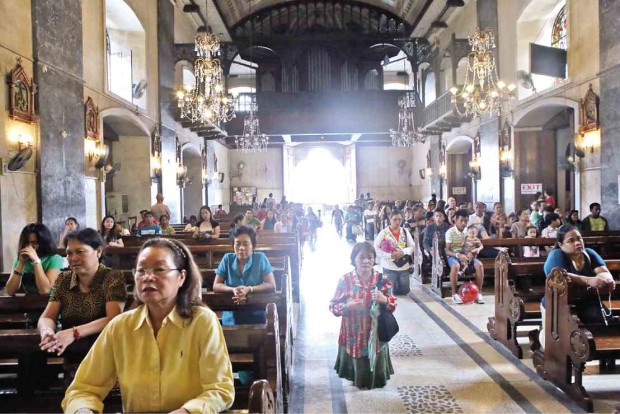
In this photo, taken Jan. 5, 2015, Catholics keeping a devotion to the Holy Child Jesus return to the Basilica del Santo Niño, home of the Santo Niño in Cebu City, after it reopened on Dec. 24, 2014, following a year of repair on quake-damaged parts of the church. (Photo by JUNJIE MENDOZA / Cebu Daily News)
CEBU CITY — A stricter enforcement on a ban on releasing of balloons. No fireworks display. A longer procession, or translacion.
These were just a few of the changes in this year’s Sinulog festival that would start on Jan. 11 and culminate on Jan. 21.
Fr. Pacifico “Jun” Nohara, OSA, rector of the centuries-old Basilica Minore del Santo Niño in downtown Cebu City.
In solidarity with victims of the five-month Marawi siege and recent storms, the Augustinian fathers would not have any fireworks display after the one-hour Sinulog dancing which followed the Pontifical Mass on the eve of the Fiesta Señor this year.
Fr. Noel Cogasa, OSA, who is in charge of the liturgical celebrations in the basilica, said the money intended for the fireworks display would instead be donated for the rehabilitation of Marawi, for storm victims, and for the renovation of a church in Villaba, Leyte.
In previous years, the basilica spent about P100,000 for the pyrotechnics display after the one-hour traditional Sinulog dance at the church’s Pilgrim Center.
Last August, the basilica already sent P300,000 in donations for victims of the Marawi siege but found the need to add some more to help victims of the war.
Fr. Aladdin Luzon, OSA, head of the Fiesta Señor 2018 peace and order committee, said they would also strictly enforce a total ban on balloons at the church courtyard.
For the past six years, the Augustinian fathers have repeatedly appealed to devotees of the Child Jesus to stop releasing balloons in the air, saying it is harmful to the environmental and had caused several power interruptions.
The plea fell on deaf ears.
“Now, we have given the go signals for the security guards to confiscate all balloons at the entrance gates of the basilica,” Luzon said.
Balloon vendors, he said, would not be allowed inside the basilica.
Devotees are also discouraged from using balloons during the foot and fluvial processions.
For several years, the release of balloons in the air during the feast of the Sto. Niño has been a popular gesture of lifting prayers to heaven.
The Augustinian fathers, the caretakers of the basilica and the image of the child Jesus, want the practice to stop, teaching devotees the proper way of expressing their faith.
For the first time, the images of the Sto. Niño and the Our Lady of Guadalupe will drop by the Nuestra Señora de Regla National Shrine in Lapu-Lapu City shortly before the start of the fluvial procession on Jan. 20, 2018.
The Augustinian fathers have decided to extend the annual traslacion from Mandaue City to the adjacent island of Mactan, particularly in Lapu-Lapu City, in response to numerous requests from Oponganons who want to be visited by the images during the festivities.
As in previous years, the traslacion – or ritual transfer of the images of the Sto. Niño and the Our Lady of Guadalupe – will start after the 5:30 a.m. Mass on Jan. 19, from the basilica to the National Shrine of St. Joseph in Mandaue where the two images will stay for an overnight vigil.
At 2 a.m. on Jan. 20, a send-off Mass will be celebrated at the National Shrine of St. Joseph. But unlike previous years, there will be no more foot procession that will bring the images of the Sto. Niño and the Our Lady of Guadalupe to the Ouano Wharf.
Instead, the images will be transported in a motorcade to the Nuestra Señora de Regla National Shrine in Lapu-Lapu City for the 4 p.m. Mass.
The images will then be brought in a motorcade to the Naval Forces Central Wharf in Barangay Looc for the start of the fluvial procession along the Mactan Channel.
After the fluvial procession, a reenactment of the first Mass, baptism, and wedding will be done at the basilica’s Pilgrim Center to be followed the grand procession of the Sto. Niño image along the main streets of Cebu City in the afternoon.
Cebu Archbishop Jose Palma will preside over the 6 a.m. Pontifical Mass at the basilica on Jan. 21, the feast of the Sto. Niño. /atm